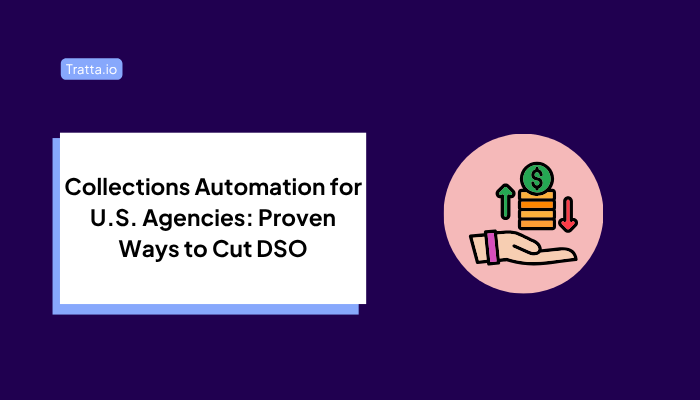
Collections agencies today face an operational squeeze. Delinquent accounts are climbing, while margins are thinning under higher compliance costs and tighter staffing. According to the Federal Reserve’s 2024 Business Payments Study, over one-third of U.S. businesses cite slow or delayed payments as a top pain point in their cash-flow operations.
Relying on manual collections, call queues, reminder spreadsheets, ad-hoc emails, might work at low volume. But once agencies are handling thousands of accounts, the model breaks down. Recovery slows, risk increases, and cost-to-collect rises.
Collections automation is the lever to reverse this equation. By digitizing outreach, workflows, and payments, agencies can cut Days Sales Outstanding (DSO), strengthen compliance posture, and improve liquidation rates, without increasing headcount. More importantly, automation frees collectors to focus on strategy and high-value negotiations rather than repetitive follow-ups.
Key Takeaways (TL;DR)
Even the most experienced collection teams struggle to maintain consistency when scale increases. The weaknesses of manual operations are systemic:
As volumes rise, these cracks widen. Accounts linger in late-stage delinquency, recovery percentages shrink, and compliance risk compounds. This is exactly the structural gap that collections automation is designed to close.
Also read: Compliance in Debt Collection Regulations
Automation in collections is not about replacing agents. It’s about ensuring every agent hour produces greater impact. When implemented well, automation shifts collections from being labor-intensive to becoming a scalable, data-driven function.
Automated workflows enforce cadence, disclosures, and channel rules that align with FDCPA, CFPB, and state regulations. Instead of relying on agents to remember dozens of rules, compliance is baked into the process.
Algorithms score accounts based on repayment probability, age of debt, and historical behavior. High-yield accounts rise to the top of the queue, while lower-probability accounts can be moved to automated reminder cycles.
Providing consumers with portals, embedded payment links, and IVR systems reduces friction. The easier it is to pay on their terms, the higher the liquidation rate.
Dashboards provide visibility into recovery performance: which outreach methods convert best, how many accounts are stuck in late delinquency, where bottlenecks exist. This allows leaders to continuously optimize outreach strategies.
The result is operational leverage. Agencies handle a higher volume of accounts, at lower cost, with stronger compliance safeguards. Collectors spend more time negotiating high-value accounts and less time chasing routine follow-ups.
Related: Collection Effectiveness Index
Agencies that implement Tratta’s automation suite resolve more accounts without increasing headcount. Explore our automation capabilities.
For collection agencies and law firms managing thousands of accounts, not every “automation tool” is equal. A true business collections automation suite must deliver more than basic reminder emails. It should provide the structural components that directly improve recovery outcomes and reduce operational drag.
Here are the capabilities leaders should expect when evaluating automated B2B collection software:
When assessing collection automation tools, agencies should treat these not as optional features but as baseline requirements for any serious platform.
Also read: Optimizing IVR for Better Self-Service
The value of collections automation isn’t abstract. It’s measured in hard operational metrics that finance leaders already track. When agencies adopt a modern automation suite, three areas typically shift first:
When leadership evaluates automation, these metrics should form the baseline scorecard. If an automation tool cannot demonstrate quantifiable improvement in DSO, liquidation, and cost-to-collect, it’s not moving the needle.
Related: Solving Common Accounts Receivable Challenges
Selecting a collections automation platform isn’t simply about features. Agencies need a partner that understands the realities of U.S. debt recovery, tight compliance, high account volumes, and constant cost pressure. The following criteria should guide evaluation:
The real test of any automation platform is whether it improves recovery outcomes while keeping agencies compliant and cost-efficient. Tratta was designed with this exact mandate.
For agencies, the result is measurable: lower Days Sales Outstanding, higher liquidation rates, and reduced cost-to-collect. Instead of adding staff, teams gain operational leverage from a digital-first suite designed for the realities of U.S. debt recovery.
Ready to modernize your collections process? Book a demo and see how Tratta brings automation to life for agencies like yours.
Collections automation is no longer a future investment — it’s the present reality for agencies managing high volumes of delinquent accounts. Manual processes drive up DSO, inflate cost-to-collect, and increase compliance risk. Automation changes this equation: faster resolution cycles, measurable recovery gains, and stronger regulatory protection.
For U.S. agencies, the question isn’t whether to automate — it’s which partner to trust with compliance, scale, and efficiency. Tratta delivers a digital-first automation suite that combines self-service repayment, embedded payments, multilingual IVR, and analytics into one platform. The outcome: more accounts resolved, lower operational costs, and collectors who can focus where their expertise matters most.
Looking to accelerate recovery while staying compliant? Book a demo with Tratta and see how U.S. agencies are using automation to cut DSO and increase liquidation rates.
Collections automation is the use of software to handle repetitive tasks like payment reminders, follow-ups, and reporting. For agencies, it ensures compliance, reduces manual workload, and improves recovery rates by digitizing the collections process.
By streamlining outreach and offering self-service payment options, automation shortens the payment cycle. Accounts are followed up faster and more consistently, which reduces Days Sales Outstanding (DSO).
Examples include automated reminder emails and SMS, IVR payment options, segmentation of accounts based on risk or value, and integration with CRMs for real-time updates.
Yes. B2B collections automation improves invoice-to-cash cycles, reduces disputes, and lowers operational costs. For agencies managing corporate accounts, it ensures efficiency and better client relationships.
Modern platforms embed FDCPA, CFPB, and state-specific requirements into workflows. They control cadence, channel usage, and disclosure language automatically—reducing the risk of regulatory violations.
Key factors include self-service portals, multi-channel engagement, integration readiness, analytics, embedded payments, and customization. Agencies should prioritize compliance-first platforms that can scale with account volumes.